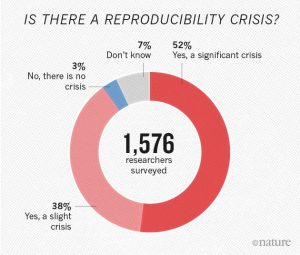The reproducibility crisis is one of the biggest challenges facing the scientific community today. A number of solutions have been proposed, but none fully respond to the issue. Read on for a unique, new solution that actually could bring more reproducibility to research.
As a scientist, I have struggled to replicate experiments previously carried out by members of my own laboratory, not to mention attempting the ones published by other groups.
Deciphering the nuances of “moderate shaking” of the eppendorf tubes or “gentle aspiration” of the supernatant was confounding! Was my definition of gentle not the same as theirs? Was this the only reason that this ‘delicate’ experiment could not be reproduced? Some of my fellow researchers even joked that it was not the details, but the “invisible forces” that guaranteed the success of experiments: breaking a test tube to ward off evil spirits or praying for the bacteria (twice daily, please). However, such recommendations only augmented my frustrations further.
This reproducibility issue is endemic in the world of scientific research and I realized that I am not alone. Recently, a study published in Nature stated that, “More than 70% of researchers have tried and failed to reproduce another scientist's experiments, and more than half have failed to reproduce their own experiments."
There is no debate anymore about whether the reproducibility crisis in science is real or not. It is real, it is huge, and it needs a solution, a rather quick one. My endeavor in writing this blog is to bring to light a solution, which just might be the precise fix that the scientific community needs.
Dr. Guikema (Academic Medical Center, University of Amsterdam at Netherlands) puts it eloquently in his words, “Reproducibility is the cornerstone of science, and it is only too often that we as scientists find ourselves incapable of reproducing experiments using the limited and concise information provided by most science journals. It is therefore that I support the efforts from the Journal of Visualized Experiments (JoVE) to increase scientific reproducibility by showing how experiments are actually performed. I believe that JoVE fulfills an important need, not only by establishing a comprehensive library of scientific techniques for reproducibility, but also by providing an interesting audio-visual teaching aid for students in a laboratory setting."
In a technologically advanced society, when science has advanced at breakneck speeds in almost every aspect, how did scientific publishing get left behind for so long? JoVE was born almost a decade ago with the mission to resolve this reproducibility crisis and appease the frustrations of scientists like myself. JoVE articles contain detailed text, highlighting scientific methods in a clear stepwise fashion, accompanied by a video demonstration. JoVE’s eagle-eyed reviewing editors also ensure that no details of the methodology are left out. The text manuscripts are reviewed and scanned even before it is presented for peer review. No other journal takes this extra painstaking step to ensure that the publications are high quality, easy to follow and, most importantly reproducible!
A professor at a local university, who is also a fan of JoVE, proudly shared, "I will ensure that my experiments are reproducible by others by publishing the protocols as videos in JoVE that other researchers can download and execute... Other paper-only (i.e. no video) protocols journals are simply not as useful as the video articles that JoVE publishes."
Currently billions of precious taxpayer dollars go towards funding research projects in all areas of science. It is imperative that the experiments published at least be reproducible in order to further the cause that they are addressing. Thankfully, there is a solution to the reproducibility crisis, other than breaking test tubes to ward off evil spirits.
.png)

